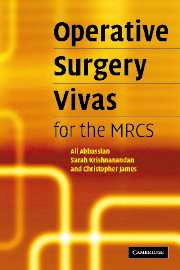Book contents
- Frontmatter
- Contents
- Preface
- 1 The elective repair of an abdominal aortic aneurysm
- 2 Adrenalectomy
- 3 Amputation (below knee)
- 4 Anorectal abscesses, fistulae and pilonidal sinus
- 5 Appendicectomy
- 6 Principles of bowel anastomosis
- 7 Breast surgery
- 8 Carotid endarterectomy
- 9 Carpal tunnel decompression
- 10 Central venous cannulation
- 11 Cholecystectomy (laparoscopic)
- 12 Circumcision
- 13 Colles' fracture (closed reduction of)
- 14 Compound fractures
- 15 Dupuytren's contracture release
- 16 Dynamic hip screw
- 17 Fasciotomy for compartment syndrome
- 18 Femoral embolectomy
- 19 Femoral hernia repair
- 20 Haemorrhoidectomy
- 21 Hip surgery
- 22 Hydrocele repair
- 23 The open repair of an inguinal hernia
- 24 Laparotomy and abdominal incisions
- 25 Oesophago-gastroduodenoscopy
- 26 Orchidectomy
- 27 Parotidectomy
- 28 Perforated peptic ulcer
- 29 Pyloric stenosis and Ramstedt's pyloromyotomy
- 30 Right hemicolectomy
- 31 Skin cover (the reconstructive ladder)
- 32 Spinal procedures
- 33 Splenectomy
- 34 Stomas
- 35 Submandibular gland excision
- 36 Tendon repairs
- 37 Thoracostomy (insertion of a chest drain)
- 38 Thoracotomy
- 39 Thyroidectomy
- 40 Tracheostomy
- 41 Urinary retention and related surgical procedures
- 42 Varicose vein surgery
- 43 Vasectomy
- 44 Zadik's procedure
20 - Haemorrhoidectomy
Published online by Cambridge University Press: 16 October 2009
- Frontmatter
- Contents
- Preface
- 1 The elective repair of an abdominal aortic aneurysm
- 2 Adrenalectomy
- 3 Amputation (below knee)
- 4 Anorectal abscesses, fistulae and pilonidal sinus
- 5 Appendicectomy
- 6 Principles of bowel anastomosis
- 7 Breast surgery
- 8 Carotid endarterectomy
- 9 Carpal tunnel decompression
- 10 Central venous cannulation
- 11 Cholecystectomy (laparoscopic)
- 12 Circumcision
- 13 Colles' fracture (closed reduction of)
- 14 Compound fractures
- 15 Dupuytren's contracture release
- 16 Dynamic hip screw
- 17 Fasciotomy for compartment syndrome
- 18 Femoral embolectomy
- 19 Femoral hernia repair
- 20 Haemorrhoidectomy
- 21 Hip surgery
- 22 Hydrocele repair
- 23 The open repair of an inguinal hernia
- 24 Laparotomy and abdominal incisions
- 25 Oesophago-gastroduodenoscopy
- 26 Orchidectomy
- 27 Parotidectomy
- 28 Perforated peptic ulcer
- 29 Pyloric stenosis and Ramstedt's pyloromyotomy
- 30 Right hemicolectomy
- 31 Skin cover (the reconstructive ladder)
- 32 Spinal procedures
- 33 Splenectomy
- 34 Stomas
- 35 Submandibular gland excision
- 36 Tendon repairs
- 37 Thoracostomy (insertion of a chest drain)
- 38 Thoracotomy
- 39 Thyroidectomy
- 40 Tracheostomy
- 41 Urinary retention and related surgical procedures
- 42 Varicose vein surgery
- 43 Vasectomy
- 44 Zadik's procedure
Summary
What are haemorrhoids and where do they occur?
They are caused by the engorgement of the internal haemorrhoidal venous plexus, which normally forms part of the anal cushions and may be internal (above the dentate line) or external (below the dentate line). They are normally found at 3, 7 and 11 o'clock in the lithotomy position.
What symptoms may be present?
Painless bleeding, discharge and irritation are common but large haemorrhoids may thrombose and infarct causing severe pain.
How are haemorrhoids classified?
1st degree These bleed but do not prolapse
2nd degree Prolapse on straining but reduce spontaneously
3rd degree Prolapse on straining and only reduce with manual assistance
4th degree Prolapsed and irreducible and may strangulate
Why should haemorrhoids be investigated?
Serious bowel pathology, for example a carcinoma or inflammatory bowel disease, must be excluded. Rectal examination, proctoscopy and sigmoidoscopy should therefore be performed in all cases.
What is the initial management of haemorrhoids?
Conservative treatments such as:
Dietary advise (with increased fibre)
Topical applicants
Reduction of stool straining
Laxatives if constipated
What treatment modalities are available in the outpatients department?
For 1st and 2nd degree haemorrhoids the following can be used:
Injection sclerotherapy: About 23 ml of sclerosant (usually phenol in oil) is injected into the submucosal pedicle causing elevation of the submucosa and tissue necrosis.
Rubber band ligation: During proctoscopy the haemorrhoid is identified and grasped using forceps. A band is applied at the base to strangulate the pile. This later sloughs off (this can also be used in 3rd degree haemorrhoids).
- Type
- Chapter
- Information
- Operative Surgery Vivas for the MRCS , pp. 73 - 76Publisher: Cambridge University PressPrint publication year: 2006



